[This document is outdated! Refer instead to the Project Tamriel wiki: https://wiki.project-tamriel.com/wiki/House_Dres]
The sigil of Great House Dres, which depicts a Sky Render holding the sacred Covenant Chain. Each chain link represents one of the founding clans of House Dres. To an unsuspecting foreigner or slave, the chains can be seen as a symbol of opression and slavery, especially given the noose-like arrangement of the chain.
Introduction
“We are of the first Khans who walked Veloth’s Way, who wandered these salts in search of our Dawn. It was upon these fields that at last, the Three blessed us with their light. For that light, and IN-SACRED-REMEMBRANCE, we live for them and the salt we walk upon. For when the Red Tower broke, only those who walked the salt kept the True Way. With Sombre Eyes, we accepted our Mother’s Gift with delight, as she smiled upon us and our Ancestors. For our unwavering loyalty and service, The Three (May-Their-Lights-Be-Eternal), bestowed upon us a garden so that the Children of Resdayn may never lax in their Remembrance and Reverence. This is our Sacred Duty, and our Purpose.”
-Lhendalzairab Uni, Wise Woman and Muthser-thil of the Lhendal Tribe (8th Precinct-of-Rememberance), Dres Lhendal
Table of Contents
- General Schematic of Dres Society
- History of House Dres
- Character Tropes
- Worldspace Implementation
- Quest & Character Implementation
General Schematic of Dres Society
The House Dres’ particular Tribunal is Sotha Sil.
Dres itself is a confederation of semi-nomadic clans that settled the Deshaan in ages past. Their public ruling body, the Covenant Council, is made up of representatives from the various clans which have retained their distinct identities, unlike the other houses. Over time, some of the clans have come under the authority of (or have become indebted to) other clans. Leadership of House Dres appears to rest in the office of the satchem-ithil, who heads the Covenant Council, though the truth, as always, is more complex.
Their society is one without generosity. They are xenophobic, unfriendly, and stern. More so than other houses, the Dres are taciturn and unapproachable. Even rather insignificant things are considered hard-won knowledge that can only be shared within the Great House, or even vassal minor clan. The Dres consider other Dunmer outside their society as misguided, while outlanders are not even recognized as sentient beings worthy of consideration.
The Dres have a deep-seated belief in their traditions, which are more ancient than those of any other Great House. They are distrustful of change and new customs. Despite their staunch traditionalism and adherence to ancient, tribalistic customs (similar to those of the Ashlanders), they are still a sophisticated industrial and agricultural powerhouse, exporting food and slaves to the rest of Morrowind. They value hard work, and though their success has largely come as a result of shameful dealings, they regard it as the result of effort and sacrifice on their part. They do not indulge themselves like the Indoril & Hlaalu do.
The various clans of House Dres live in extended family units. Each clan is led by a local council, which in turn is led by a suzerain. Every clan is bonded through the sacred Covenant Chain, a symbol of the bargains and alliances made to unite the disparate families of the Deshaan.
Economically, the house depends on the cultivation and export of saltrice, utilizing a large pool of slaves to power the machinery that makes the Deshaan Plains the breadbasket of Morrowind. They trade only at the edges of their society (and territory), and don’t let outsiders in or travel out themselves. Making and getting good bargains (both within the society and without) is essential to their identity, without regard to the concepts of fairness.
History of House Dres
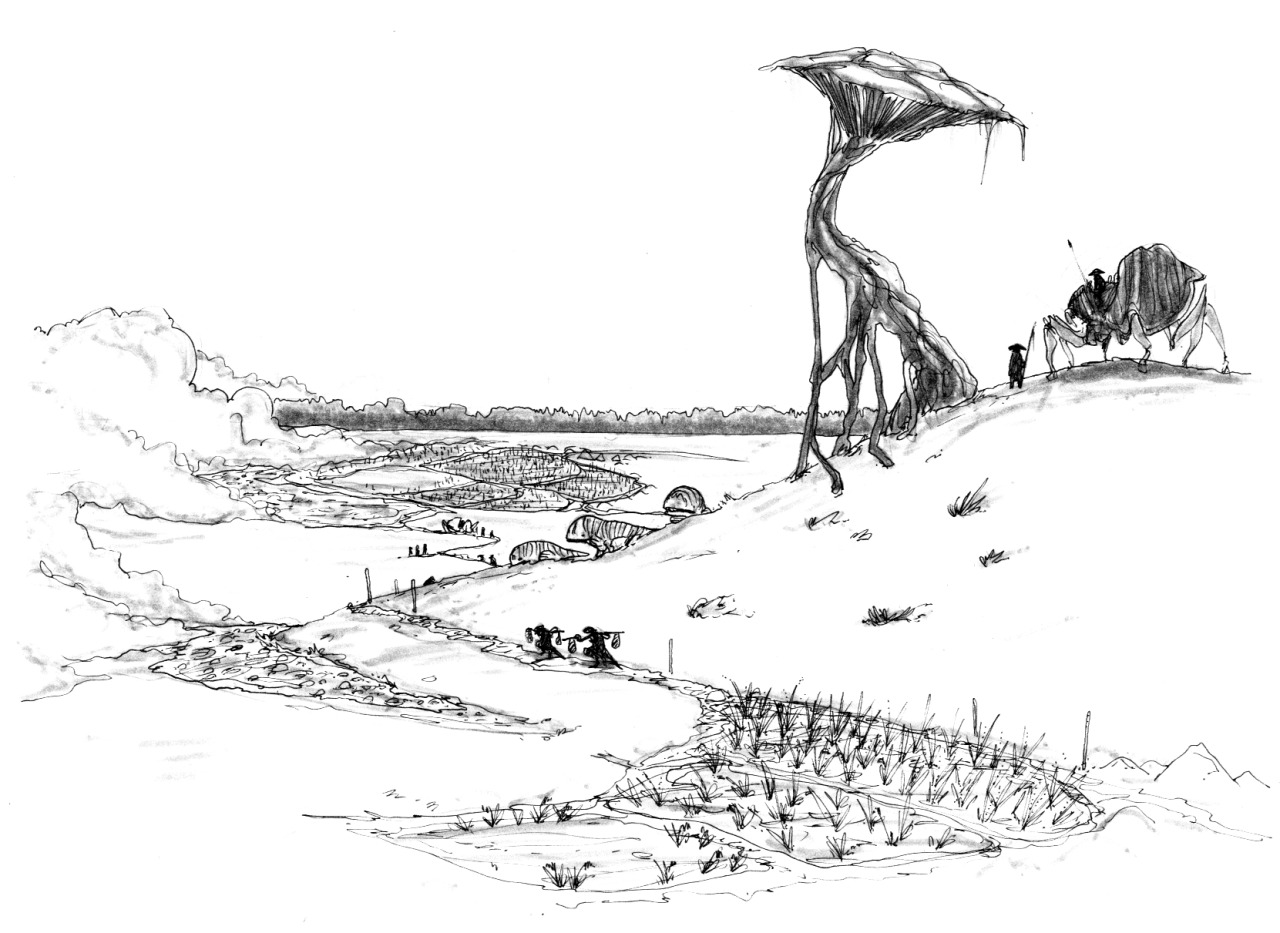
The Deshaan Plains - The homeland of the clans and tribes that eventually coalesced to become House Dres. (Art by Lutemoth)
House Dres traces its origins to the Cantemiric Velothi, a nomadic collection of clans that moved into the hostile Deshaan Forests and subsided on slash-and-char agriculture before moving on.
In their wake came the Saltwalkers, Chimeri nomads who eked out a living herding fauna. Before the eruption of Red Mountain desolated the great forests, they often lived in close relationship to the Cantemirics. Afterwards, the Saltwalkers held court in the ruins of Cantemiric civilisation while those moved beyond the Salt Marshes into Argonia.
When the Argonians flooded the Arnesian lands, the surviving Cantemirics rejoined the Saltwalkers. From this union came House Dres.
After the War of the First Council, the Annunciation of the Tribunal was interpreted differently by different houses. In the south, around the Deshaan and on the southeastern coast, the predominant local variation of the Tribunal faith would become a heterodox tradition once the Indoril theology became accepted as the universal orthodoxy. These schismatics regard the Tribunal as the Realization of the Good Daedra, rather than seeing the Good Daedra as the Anticipations of the Tribunal. They accept the Tribunals' divinity, but in a way which maintains an equality with (or possibly a certain inferiority to) Daedra, rather than holding the Tribunal to be the greatest and most mighty divinity imaginable. The Dres view saints as heroes rather than revere them as holy beings. They maintain different burial rites and records of ancestry from those of the north, and did not send dead to Necrom until the Tribunal required it for the Ghostfence (which remains a controversial point).
In the late First Era, the various nomadic clans united under House Dres, though many still maintain a loyalty to their particular minor house or clan rather than to the Dres identity proper. This also consolidated economic control over the region, and It was around this time that the Dres learned to grow saltrice in the Deshaan. Morrowind did not always benefit from the huge saltrice yields that have become a staple crop for much of eastern Tamriel. It was through a deal with the Sload that the Dres learned how to maintain the water pumps that have enabled agriculture in the Deshaan (a deal that would be repaid upon the death of those Dres who struck it). In an attempt to double-cross the Sload, they also brokered a contingency deal with a consortium of Daedra, one that gave them what they perceived to be immortality, though the specifics of this deal are not widely known (more on this below).
At first, the Dres relied on Hlaalu slaves brought from Elsweyr for the majority of their labor force. During the Middle Dawn, however, Dres leaders made a secret trade deal with the Hist, one which would be their downfall if it was discovered. They traded a small number of Dunmer to the Hist in exchange for a huge amount of Argonian slaves. Things almost came to a head in the Arnesian War, when one of the Dunmer thus traded attempted to escape, but for now the Dres have kept a lid on the externalities of their deals with the Hist.
On The Secret Bargains of House Dres & The Arnesian War [spoilers]
As stated above, Dres society relies upon trade and making bargains, always aiming to achieve the better end of the deals they make with others. They favor their own. Anything a fellow Dres might have to bargain with inherently worth more than whatever an outlander has to offer. Those outlanders who wish to trade with the Dres must have assets of considerable value. The Dres do not put much emphasis on the exchange of material currency, preferring the exchange of goods.
During the course of history, the Dres made three bargains in particular, that affect their situation in the present.
The first deal was made shortly after the Battle of Red Mountain. Ravaged by war, and facing servitude to Indoril hegemony, the Dres searched for any opportunity to retain their cherished independence. Yet their lands were bleak and desolate. The toxic nature of Deshaan’s salt required exhaustive purification which the Dres could ill-afford, limiting its use as a resource. If the Deshaan were to be used, it had to be changed. The Sload, it turned out, had a way to do just this.
Thus the secretive Dres matriarchs struck a bargain with the Sload: the souls of the matriarchs in exchange for the secret of tilling salt. The Dres realized that this required them to give the Sload a conduit to access Dunmer souls—which they saw as the foulest of blasphemies. More concerned with their independence than with tradition, the matriarchs made the deal, already searching for a way to circumvent the Sload’s price.
When the time came though, it became evident that a workaround was not possible without additional intervention. In a desperate move, the matriarchs made a pact with a consortium of Daedra that would grant them immortality by accepting a unique form of vampirism. They viewed this move as a necessary sacrifice that would allow them to maintain their hegemony for the greater good. (The general details are not disclosed in-game, but will be described in the section below.)
Yet the Dres soon learned that the secret of salt farming alone was insufficient: they needed bodies to till the fields. Slaves frequently perished in the Deshaan’s brutal climate. Raiding Black Marsh and trading with Hlaalu slavers did not net enough workers for the Dres’s needs. So it was that the Dres made yet another pact, this time with the unknowable Hist of Black Marsh. In exchange for a few Dunmer, the Hist would guarantee a steady supply of Argonian slaves that would till the salt for the Dres. But in 3E 396, one of these Dunmer (who the Temple would eventually canonize as Saint Roris), managed to escape the Hist and was killed in uncertain circumstances, triggering what is now known as the Arnesian War.
While the details surrounding the war's early days remain murky, the crisis quickly escalated. Hordes of Argonians invaded the Deshaan. The fragmented nature of Dres leadership made it difficult for them to rally the clans, and the Argonians quickly overwhelmed their militias and took possession of the Salt Marshes. The initial response from the other Dunmer nations was slow, as this was seen as a localized conflict. This quickly changed when the Dres clanstead of Bashipal was put under siege, putting enemy forces uncomfortably close to the Hlaalu in Narsis and threatening their trade routes on the Southern Thirr.
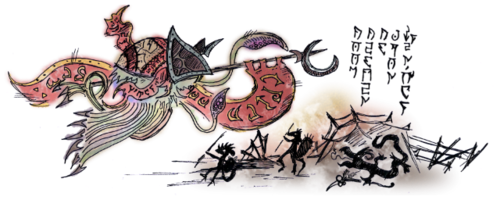
A pictorial depiction of the Night of the Thousand Lamps, also known as The Skylamp Night. (Art by Rats)
At this point, the course of the war changed. Many Dunmer now saw the war as a righteous one waged for the defense and honor of their homeland. For the Dres leaders though, it was a war to save face. Should the rest of Morrowind learn that the Dres’s own blasphemous machinations triggered these hostilities, it would surely spell the end of the house. The Siege of Bashipal was eventually broken when bands of Hlaalu soldiers from the Shipal-shin, augmented by Redoran warriors from Marak, arrived from the west. At this point, the Indoril and Temple had also joined the war out of religious fervor and a desire to correct what they termed "The Southern Anomaly". Battles were fought all over the Southern Deshaan, at Sul, and eventually at Tear, where the war culminated in a final defeat to the Argonian force in the Night of the Thousand Lamps (a native account of the battle can be read here).
While the alliance of Dunmer managed to eventually stave off the invasion (even managing to take some land from the Argonians), the troubles that plague the Deshaan and the Dres have only gotten worse. The stage is set, as the consequences from the external bargains the Dres have struck have finally come knocking at their door.
On the Nature of the Dres' "Vampirism"
One of the bargains the Dres struck involved gaining the "immortality" they needed to avoid repaying their debt to the Sload. To do this, leaders of several influential Dres clans entered into personal pacts with certain Daedra in exchange for powers that would indefinitely delay their deaths. These powers, while sharing characteristics with typical blood vampires, are distinct from traditional vampirism in several ways. In addition to these powers, which the Dres matriarchs themselves saw as a curse, their newfound vampirism omitted them from ancestry, which is to them, a very big deal.
To add insult to injury, a stipulation of this bargain in particular was the fact that these Dunmer had to feed on their own kin to sustain their life force, or suffer mentally debilitating side-effects. Some resisted by instead drinking the blood of slaves, but those who did suffered migrane-aura visions and nightmares. As the matriarchs carry the functions of wise-women within their individual clans, abstaining from Dunmer blood greatly affects their ability to rule and make sound judgements. Despite what they themselves have become, they still view the consumption of Dunmer blood as distasteful, and are slowly paying the price for this decision.
In essence, the Dres leadership have become what they most despise, though they still view their abominable status as a self-sacrifice for the greater good. Their condition is known only to their closest and most trusted kin. Were it to be known beyond, they would pay the ultimate price. In order to conceal this, they don special masks of crystalline clay and resin that resemble various abstract and natural forms (symbolizing beliefs and clan customs). The appearance of Dres vampirism is not as severe as those of other vampires, as their skin is not as pale or deformed (their NPCs will use custom heads, and not vampire heads).
The player will not be able to contract this kind of vampirism, as it was designed specifically for the Dres council. The curse has put the matriarchs in a severely weakened state, forcing them to rule by proxy and seclude themselves in their quarters (they still suffer from Sun Damage, like other vampires). They are distrustful and generally closed-off to the player, even other Dres.
Character Tropes and Structure of Dres Society
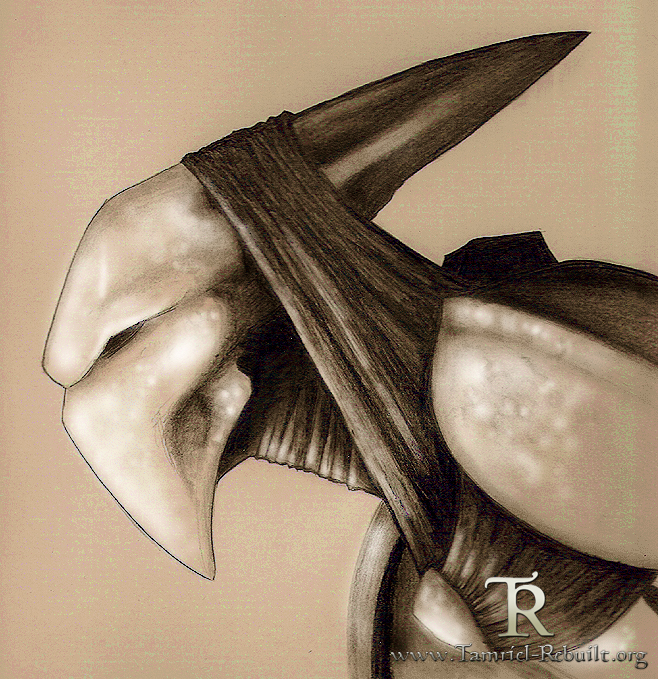
Concept of a Dres Slave Hunter. (Art by Nalin)
As stated above, the Dres are a coalition of various clans, in which some clans are more powerful than others. In each clan they have an internal structure that roughly resembles those of their nomadic Ashlander cousins. While the Ashlanders developed a society that practices a sharp division of spiritual and martial leadership between the wise women and the ashkhan/gulakhan roles, the Dres took a different path.
Broadly speaking, Dres society can be broken into roughly three groups: The Dres leadership, the kin and retainers of the various clans of Dres, and the slaves that actually toil the fields of the Deshaan. A fourth category of unaffiliated Dunmer and Outlanders in the peripheral settlements of Dres territory is also included.
Outlanders & Other Dunmer
Asides from the occasional envoys from other factions, unaffiliated Dunmer and Outlanders are rare in the Deshaan. It is one of the most closed-off areas of Morrowind, due to the Dres’ attitude towards foreigners. Several outlanders can be found trading with the Dres at the port cities of Tear and Dres Horak. Some outlanders are also used in skilled trades as craft slaves. Dres Horak is popular with Indoril traders (and some from Hlaalu) stopping over to fill their holds with saltrice, while Tear is a frequent stopover for independent and Telvanni-aligned slave traders. The outlander guilds have a minimal presence in Tear, and often operate out of sight to avoid drawing the ire and suspicion of the Dres.
Slaves
While considered a means to an end by most Dres, slaves form an incredibly important component of their society. The Dres do not shy from viewing slaves as tools, and not sentient beings. The majority of slaves found in the Deshaan are Argonians. Many were captured during the Arnesian War, when the Dres managed to capture the Salt Marshes from Black Marsh, and in subsequent raids thereafter. However, many Argonians were imported into the territory as a result of a secret deal with the Hist. While Argonians are seen as best suited for tilling the fields, a sizeable number of slaves from other races are utilized by the Dres, in a number of different applications (away from the salt fields).
Slaves are also utilized as cattle by the vampiric leadership of the Dres, and are easily replaceable. Thus it is not uncommon for slaves to disappear frequently from their holding pens, though this practice is only carried out by the most trusted of retainers.
Slaves can be found in all Dres holdings, and in the numerous saltrice paddies around Deshaan. A sizeable amount are available for trade in the infamous pits of Tear. A holding of Argonians can also be found in the pit at Dres Sul, which is often where the Dres Foragers drop off their captive slaves after returning from raids into Argonian territory.
Dres Clansmer
The Dres leaders defer much of the daily business of the House to the various members of their families, as well as their retainers and overseers. While administrative tasks such as negotiating trade, mediating political conflicts between the various clan-families fall to the immediate-kin of the Muthser-thil, field operations are almost always handled by retainers and overseers. Other independent Dres that have not been adopted into a particular clan are bugherders, who operate saltrice paddies under the jurisdiction of a particular Nomarch, or oversee trade operations in Dres’ external settlements. Guards and Foragers are often employed in the service of a particular clan. Despite the 'secret' dealings of the Dres leaders, the Dres are not typically seen as a secretive society. They are abrasive and direct, and will make their views and beliefs known to anyone in plain sight. They value their trade, and are extremely proud of their traditions, rigid and unwavering in their practice and application of their customs. Unlike other societies, the Dres do not see themselves as superior to their own kin, and class systems are generally nonexistent. Every mer has a role to play in the clan, and each role is generally seen with equal status and importance.
Dres Leadership
The public leadership of House Dres rests in the Covenant Council, which consists of clan representatives led by the satchem-ithil. The Covenant Council is migratory, and goes from clanstead to clanstead in order to mediate disputes and negotiate policy. They alone determine House Dres policy toward non-Dres (whether Dunmer or not).
The members of the Covenant Council will typically meet with local clan councils (who consist of prominent Dunmer within that clan, led by an elected suzerain). Ideally, a balance is struck between an individual clan’s needs and those of House Dres as a whole. In general, Dres tend to be conservative, and err on the side of security and the status quo.
True leadership lies in the matriarchs. Within a single clan, a matriarch acts as a powerbroker of sorts, determining who becomes suzerain and who is elected to the Covenant Council. This role has decreased as the matriarchs become ever more reclusive. Within House Dres as a whole, the matriarchs dictate policy with a mind to both maintaining order and hiding the blasphemous secret behind Dres prosperity. Though a matriarch’s word is not officially law, it carries so much social weight that no Dres would dare act against it.
Matriarchs garb themselves in shadow and mystery. Though they reside in the clanstead’s council halls, they speak rarely and always from behind a screen that obscures their features. A matriarch will rely on a single trusted assistant, who is always a woman. The assistant takes care of her matriarch’s day-to-day needs, and attends council meetings (also from behind a screen).
It is understood that the assistant will act as the matriarch’s successor. In truth, of course, the matriarchs are effectively immortal, and simply use the assistants as a way to maintain the illusion of a transfer of power.
The matriarchs themselves rarely meet. House Dres does maintain a propylon network, with one propylon per clanstead. This can be used on the unusual occasions in which the matriarchs most confer with one another. Messengers may be entrusted to use the propylon network on a per-job basis. The satchem-ithil alone has access to all of the propylons.
Worldspace Implementation of Dres Territory
Architectural Characteristics and Settlement Space Layout
Settlement spaces in the Deshaan can be roughly classified into three major categories: the major cities, clan strongholds, and saltrice paddies. Other settlement spaces such as nomadic camps and slaver outposts are also present in the region. Dres architecture is composed of three elements: the fortress-like hexagonal platforms which are central to all Dres settlements, the modular house-towers for additional structures and houses, and the bugshell dwellings primarily used by the Chap-thil. Each set is used differently based on the type and character of the various settlement spaces.
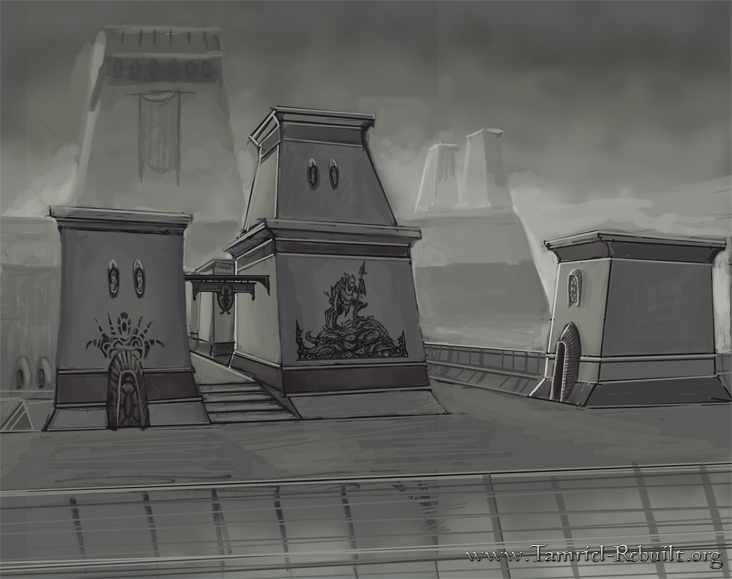
Old concept art of a muraled-building in Dres Tyr. The Dres will often adorn their structures with symbolized representations of ancestral totems, or other nationalistic imagery. Depicted here is the Dunmer victory over the Argonians in the Arnesian War, possibly as a message to deter restive slaves from any foolish actions. (Art by Turelio)
Major Cities: The Dres have two major settlements, Tear, and Dres Horak, which are found at the eastern and western peripheries of their territory respectively. Though Tear is the largest city in Dres territory, it is truly more of a slave market that the Dres set up for the sole purpose of trading with outsiders (including the Dunmer of House Telvanni). Unscrupulous traders of all races can often be found in Tear, as it’s geographical location offers relative isolation from the laws and regulations of the Empire. The Dres themselves view Tear with no small amount of disdain.
Dres Horak is more truly a Dres city. It is from here that much of the region’s saltrice is exported to the rest of Morrowind. Dres Horak was once a traditional clanstead, but has long since grown beyond its platform and into the surrounding countryside. The Dres here are generally distant and reserved, and have few other services to offer to outlanders, with the exception of bartering for minor goods and offering shelter (at exorbitant prices).
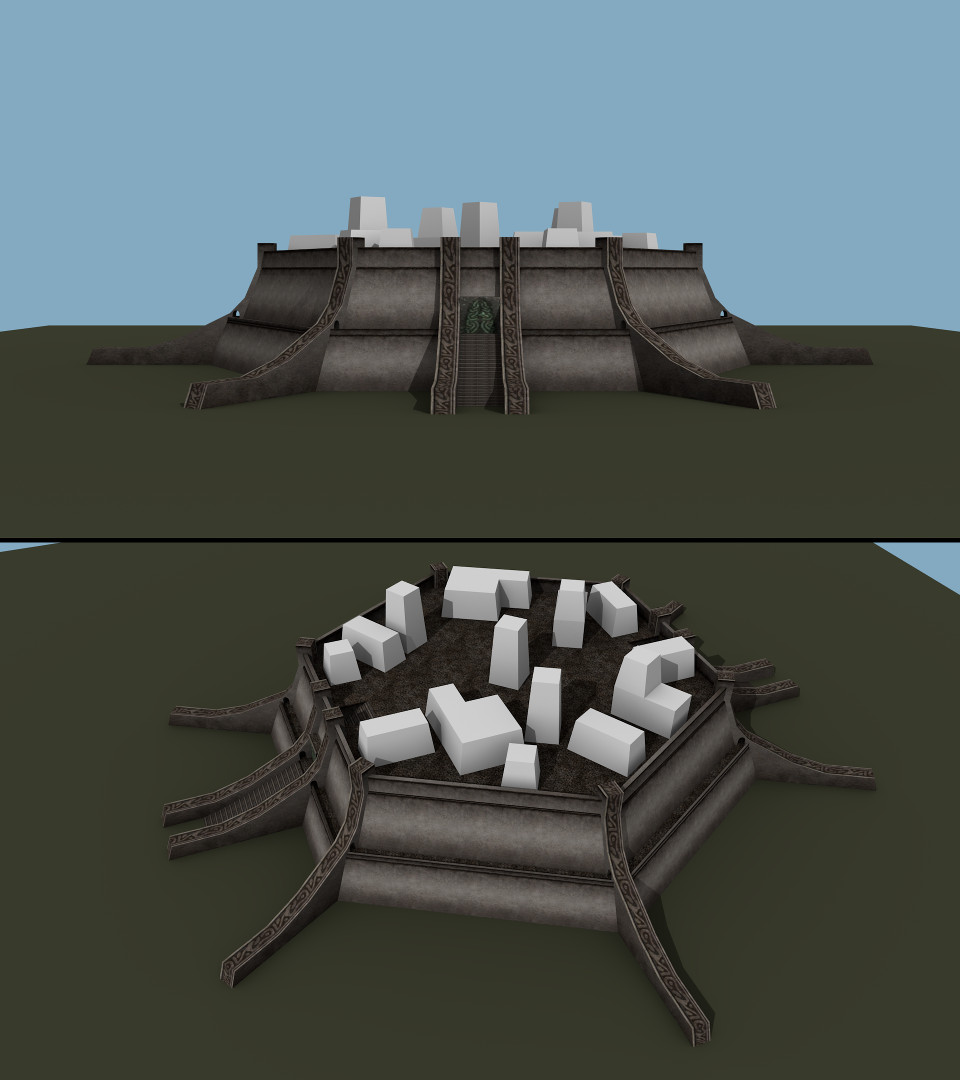

Early 3D concepts of what Dres' canton-strongholds could look like. Their hexagonal shape is symbolic of their reverence of the Three Good Daedra and their Tribunal counterparts. (Concept by FloorBelow)
Clansteads: The majority of the traditionalist Dres clans live in clansteads that dot the numerous byways of the Deshaan. These were once Chimer strongholds where the various nomadic tribes of the region would meet and trade with one another. As time passed, several clans have since entrenched themselves and used the strongholds as their homesteads. Most of the Dres live on platforms raised above the land, though they have a few additional structures such as slave pens. It is also not uncommon to see a few semi-nomadic dwellings on the peripheries of the strongholds.

Current iteration of a detached Dres dwelling in-game. These are more common in the larger citites, rather than the interior canton-strongholds. Featured on the facade of the building is some larva gel graffiti beside the doorframe, and the larva lamp above it. Some Dres also store ancestral urns in tiny alcoves in their dwellings, as pictured here. Since this is still a test model, it is not depicted in its actual setting. (Models by Mwgek)
Saltrice Paddies & Outposts: The remainder of the Dres settlements take the form of saltrice paddies and slaver outposts. These are relatively small, and don’t have a lot of services, if any. The paddies often have a holding for the owners, barracks for overseers and other servants, and slave pens for the slaves that till the fields. The main holding is separate from the slave pens and are walled for additional protection. A paddie is dependent upon the clanstead it serves.
Main Settlement Spaces
Major Cities: Tear (I), Dres Horak (II)
Clan Strongholds: Dres Lhendal (III), Dres Sul (III), Dres Felyon (III), Dres Hairab (IV), Dres Bashipal (IV), Dres Yengrith (IV, player)
Numerous saltrice paddies and outposts (VI).
Faction Relations
The Dres view the rest of Morrowind in much the same way that Morrowind views the rest of Tamriel: full of uncouth outsiders who are best kept at a distance, and only allowed inside when circumstances or profit require their presence. Relations with other factions tend to be minimalistic.
The Empire rules the Deshaan in name only. The torrid climate, the hostility of the natives, and the important role slavery plays within the province’s economy give the Empire’s authorities little reason to interfere or look too closely.
The Tribunal Temple is uncomfortable with the Dres’s unusual approach to faith. However, they also see Dres traditionalism as a source of comfort in these trying times. Though the Temple would like to strengthen its influence in the Deshaan, and correct the flaws in Dres theology, they have too many more pressing matters to make it a priority.
- The Hlaalu look down on the Dres as rustic savages, while the Dres sneer at Hlaalu haughtiness. Nonetheless, the two houses frequently trade with one another. The Dres have taken note of Hlaalu expansionism but do not yet see it as a matter of great concern.
- The Redoran have few real dealings with the Dres. Neither house thinks much about the other.
- Despite their differences, House Indoril bears a certain respect for House Dres, in part because the Dres make no claim to Indoril lands. Both are also distrustful of outsiders and in favor of tradition, though the nature of their traditions differs greatly.
- House Telvanni buys many of the Argonians enslaved by House Dres. This relationship is strictly business: the houses have little to do with one another, and the Dres despise Telvanni arrogance and blasphemy.
Faction Ranks
- Satchem-ithil
Leader of House Dres, Grand Chief of the Covenant Council. Due to the control the Matriarchs have over Council membership, it is currently a puppet rank, with less real power than most of the Dres realize. Lives a nomadic life travelling between clansteads with the Council. - Suzerain
A leader elected by a clan council to perform particular duties for the clan, generally simply heading the clan council, or leading clan warriors in wartime. The appointment is generally temporary.
Player's rank when they sit on the Dres council, once their clan leadership has been confirmed. - Muthser-thil
Member of a Dres clan council. Generally an elder, but could also be a veteran warrior or prominent Chap-thil or otherwise someone who has demonstrated their worth to the clan. - Nomarch
An administrative ruler tasked with administering clan holdings, generally the saltrice plantations. The player receiving this title advances their standing.
- Molag-thil
A member of a clanstead/clan that controls (significant) territory. It being such a high rank only really applies to the player; most are born into it. (Keep that in mind for NPCing.) - Chap-thil
An owner of a bug herd, usually but not necessarily a member of a Dres clanstead. - Overseer
A Dres that has been put in charge of something important [middling rank]. - Crewman
A Dres working for someone else. - Bondman
An initiated member of House Dres. - Oathman
Taken an oath to serve House Dres exclusively.
Link dump:
Dres: https://www.tamriel-rebuilt.org/old_forum/viewtopic.php?t=24033
Dres: https://www.tamriel-rebuilt.org/forum/house-dres-brainstorming
Dres: https://www.tamriel-rebuilt.org/forum/house-dres-documentation
Sload: https://www.tamriel-rebuilt.org/old_forum/viewtopic.php?t=24957
Dres farming: https://www.tamriel-rebuilt.org/old_forum/viewtopic.php?t=24055
Sky Port: https://www.tamriel-rebuilt.org/old_forum/viewtopic.php?t=23936
History: https://www.tamriel-rebuilt.org/house-dres-history
Vampirism: https://www.tamriel-rebuilt.org/content/dres-vampirism
Vampires: https://www.tamriel-rebuilt.org/forum/deshaan-vampires
Future Dres: https://www.tamriel-rebuilt.org/forum/house-dres-future
Red Moment: https://www.tamriel-rebuilt.org/forum/hist-red-moment
The Hist: https://www.tamriel-rebuilt.org/forum/hist-reexamined
Questline: https://www.tamriel-rebuilt.org/content/house-dres-faction-questline-wip
Questline: https://www.tamriel-rebuilt.org/forum/house-dres-faction-quests
Dres concepts: https://www.tamriel-rebuilt.org/old_forum/viewtopic.php?t=25146&start=0
[Concept Art] Dres: https://www.tamriel-rebuilt.org/old_forum/viewtopic.php?t=15269
[Concept Art] Dres: https://www.tamriel-rebuilt.org/old_forum/viewtopic.php?t=15293
Settlements: https://www.tamriel-rebuilt.org/forum/house-dres-settlements-brainstorming

